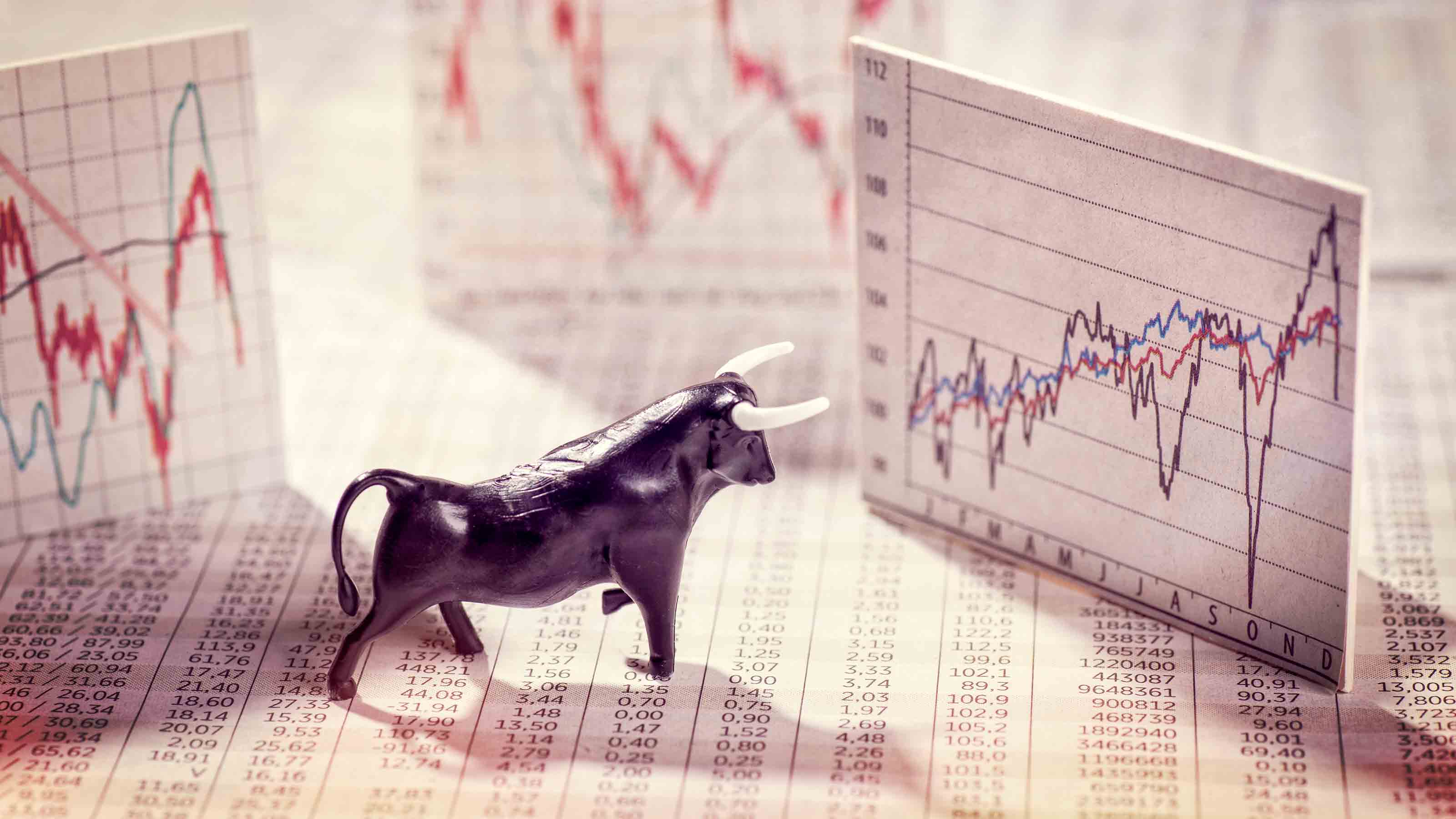33 Stocks That Could Rally 50% or More This Year
Analysts say these S&P 500 stocks have at least 50% price upside over the next year or so.


The bull market came to an abrupt halt midway through the first quarter, with the broader market losing more than 14% since its February peak. Although that's not particularly reassuring, a downbeat start to 2025 should theoretically mean that lots of stocks are on sale.
Before we get to stocks with the most upside potential based on industry analysts' average price targets, let's put our current market in perspective.
The S&P 500 is off more than 10% for the year to date through late April. That's not ideal, but it's hardly a wipeout. Note that the main benchmark for U.S. equity performance was at this price level in August.

Sign up for Kiplinger’s Free E-Newsletters
Profit and prosper with the best of expert advice on investing, taxes, retirement, personal finance and more - straight to your e-mail.
Profit and prosper with the best of expert advice - straight to your e-mail.
It's also worth mentioning that the S&P 500 is up more than 6% on a price basis over the past 52 weeks.
It's understandable if this context offers little solace to jittery investors at this precarious time for equities.
After all, tariff uncertainty and rising recession odds are complicating the outlook for corporate earnings. Be that as it may, a bottom-up look at the S&P 500's constituents reveals that analysts remain bullish on scores of names despite rising macroeconomic uncertainty.
How can this be?
Cheaper valuations equal higher returns
Recall that equities were historically pricey before the stock market correction. If a stock's price falls faster than its earnings prospects, it can start to look like a bargain.
And if a stock gets slammed out of proportion to its estimated operating earnings, it can appear to be a screaming buy.
That helps explain how a total of 33 stocks in the S&P 500 have implied upside of at least 50% over the next 12 months or so, according to price target data from S&P Global Market Intelligence.
But before we get to the S&P 500 stocks that could rally the most based on price targets, a caveat is in order.
Price targets are a blunt tool when it comes to sussing out cheap stocks. Committing capital based on a single data point is not an investment process.
It's also important to note that stocks with the most upside potential don't necessarily get consensus Buy recommendations from the very same analysts whose models spit out the target prices.
With that warning out of the way, if you're looking for beaten-down stocks with the most upside potential, the names listed below aren't a bad place to start.
Company (Ticker) | Average price target | Upside to price target | Consensus recommendation score | Consensus recommendation |
Moderna (MRNA) | $51.14 | 107% | 2.78 | Hold |
Micron Technology (MU) | $127.58 | 85% | 1.50 | Strong Buy |
First Solar (FSLR) | $232.12 | 81% | 1.56 | Buy |
Deckers Outdoor (DECK) | $189.99 | 80% | 1.87 | Buy |
Norwegian Cruise Line Holdings (NCLH) | $28.96 | 77% | 1.79 | Buy |
Western Digital (WDC) | $64.02 | 75% | 1.71 | Buy |
Caesars Entertainment (CZR) | $44.40 | 74% | 1.53 | Buy |
Albemarle (ALB) | $91.55 | 73% | 2.57 | Hold |
Las Vegas Sands (LVS) | $55.71 | 70% | 1.56 | Buy |
Stanley Black & Decker (SWK) | $95.90 | 68% | 2.65 | Hold |
Global Payments (GPN) | $114.97 | 66% | 2.19 | Buy |
Bio-Techne (TECH) | $79.70 | 66% | 1.80 | Buy |
ON Semiconductor (ON) | $57.08 | 65% | 1.93 | Buy |
Super Micro Computer (SMCI) | $51.77 | 64% | 2.71 | Hold |
MGM Resorts International (MGM) | $47.44 | 64% | 1.52 | Buy |
Warner Bros. Discovery (WBD) | $13.27 | 64% | 2.19 | Buy |
Nvidia (NVDA) | $165.66 | 63% | 1.40 | Strong Buy |
Biogen (BIIB) | $191.39 | 61% | 2.20 | Buy |
Microchip Technology (MCHP) | $62.04 | 61% | 1.79 | Buy |
Advanced Micro Devices (AMD) | $140.48 | 61% | 1.94 | Buy |
EPAM Systems (EPAM) | $235.78 | 60% | 2.09 | Buy |
Viatris (VTRS) | $12.03 | 59% | 2.56 | Hold |
GE HealthCare Technologies (GEHC) | $98.95 | 59% | 1.75 | Buy |
Regeneron Pharmaceuticals (REGN) | $890.34 | 58% | 1.81 | Buy |
Teradyne (TER) | $111.27 | 56% | 1.88 | Buy |
Carnival Corp. (CCL) | $28.02 | 56% | 1.72 | Buy |
IQVIA Holdings (IQV) | $223.21 | 55% | 1.60 | Buy |
Generac Holdings (GNRC) | $172.23 | 54% | 1.96 | Buy |
Arista Networks (ANET) | $107.87 | 52% | 1.73 | Buy |
Zebra Technologies (ZBRA) | $342.52 | 51% | 2.00 | Buy |
Charles River Laboratories (CRL) | $159.11 | 50% | 2.85 | Hold |
Dell Technologies (DELL) | $127.06 | 50% | 1.54 | Buy |
Salesforce (CRM) | $368.75 | 50% | 1.75 | Buy |
Data as of April 18, courtesy of S&P Global Market Intelligence.
Related content
Profit and prosper with the best of Kiplinger's advice on investing, taxes, retirement, personal finance and much more. Delivered daily. Enter your email in the box and click Sign Me Up.

Dan Burrows is Kiplinger's senior investing writer, having joined the publication full time in 2016.
A long-time financial journalist, Dan is a veteran of MarketWatch, CBS MoneyWatch, SmartMoney, InvestorPlace, DailyFinance and other tier 1 national publications. He has written for The Wall Street Journal, Bloomberg and Consumer Reports and his stories have appeared in the New York Daily News, the San Jose Mercury News and Investor's Business Daily, among many other outlets. As a senior writer at AOL's DailyFinance, Dan reported market news from the floor of the New York Stock Exchange.
Once upon a time – before his days as a financial reporter and assistant financial editor at legendary fashion trade paper Women's Wear Daily – Dan worked for Spy magazine, scribbled away at Time Inc. and contributed to Maxim magazine back when lad mags were a thing. He's also written for Esquire magazine's Dubious Achievements Awards.
In his current role at Kiplinger, Dan writes about markets and macroeconomics.
Dan holds a bachelor's degree from Oberlin College and a master's degree from Columbia University.
Disclosure: Dan does not trade individual stocks or securities. He is eternally long the U.S equity market, primarily through tax-advantaged accounts.
-
 I'm 58 and unexpectedly inherited $650K. Does this change my retirement timeline?
I'm 58 and unexpectedly inherited $650K. Does this change my retirement timeline?We asked an expert financial adviser to weigh in.
-
 Why Smart Retirees Are Ditching Traditional Financial Plans
Why Smart Retirees Are Ditching Traditional Financial PlansFinancial plans based purely on growth, like the 60/40 portfolio, are built for a different era. Today’s retirees need plans based on real-life risks and goals and that feature these four elements.
-
 Why Smart Retirees Are Ditching Traditional Financial Plans
Why Smart Retirees Are Ditching Traditional Financial PlansFinancial plans based purely on growth, like the 60/40 portfolio, are built for a different era. Today’s retirees need plans based on real-life risks and goals and that feature these four elements.
-
 To My Small Business: Well, I've Been Afraid of Changin', 'Cause I've Built My Life Around You
To My Small Business: Well, I've Been Afraid of Changin', 'Cause I've Built My Life Around YouWhile thinking about succession planning might feel like anticipating a landslide (here's to you, Fleetwood Mac), there are strategies you can implement to manage the uncertainty and the transition.
-
 Stock Market Today: S&P 500, Nasdaq Near New Highs
Stock Market Today: S&P 500, Nasdaq Near New HighsThe S&P 500 hasn't hit a new high since February. It's been since December for the Nasdaq.
-
 The Bull Case for the Second Half of 2025
The Bull Case for the Second Half of 2025This strategist sees a volatile market segueing to a strong close this year.
-
 7 Essential Investing Rules We All Should Know
7 Essential Investing Rules We All Should KnowThe best time to start investing is right now. That's just one vital rule investors should be familiar with. Here are six more.
-
 These Are the Key Tariff Issues to Watch in Coming Months
These Are the Key Tariff Issues to Watch in Coming MonthsWhile they're not dominating headlines right now, tariffs are not over. Some key dates are coming up fast that could upend markets all over again.
-
 Technology Unleashes the Power of Year-Round Tax-Loss Harvesting
Technology Unleashes the Power of Year-Round Tax-Loss HarvestingTech advancements have made it possible to continuously monitor and rebalance portfolios, allowing for harvesting losses throughout the year rather than just once a year.
-
 The Fiduciary Firewall: An Expert's Five-Step Guide to Honest Financial Planning
The Fiduciary Firewall: An Expert's Five-Step Guide to Honest Financial PlanningArmed with education and awareness, you can avoid unethical people in the financial industry by seeking fee-only fiduciaries and sharing your knowledge with others.